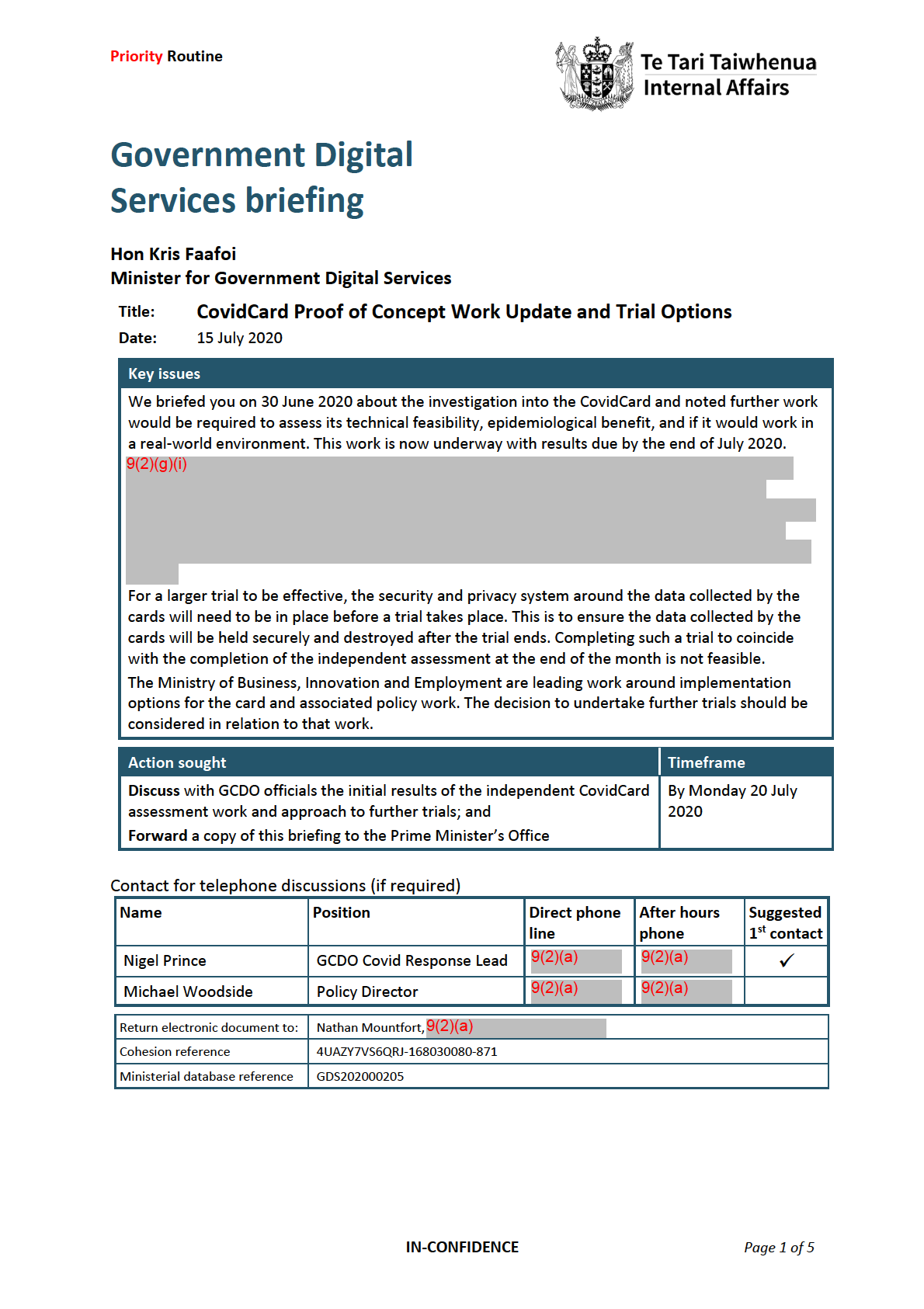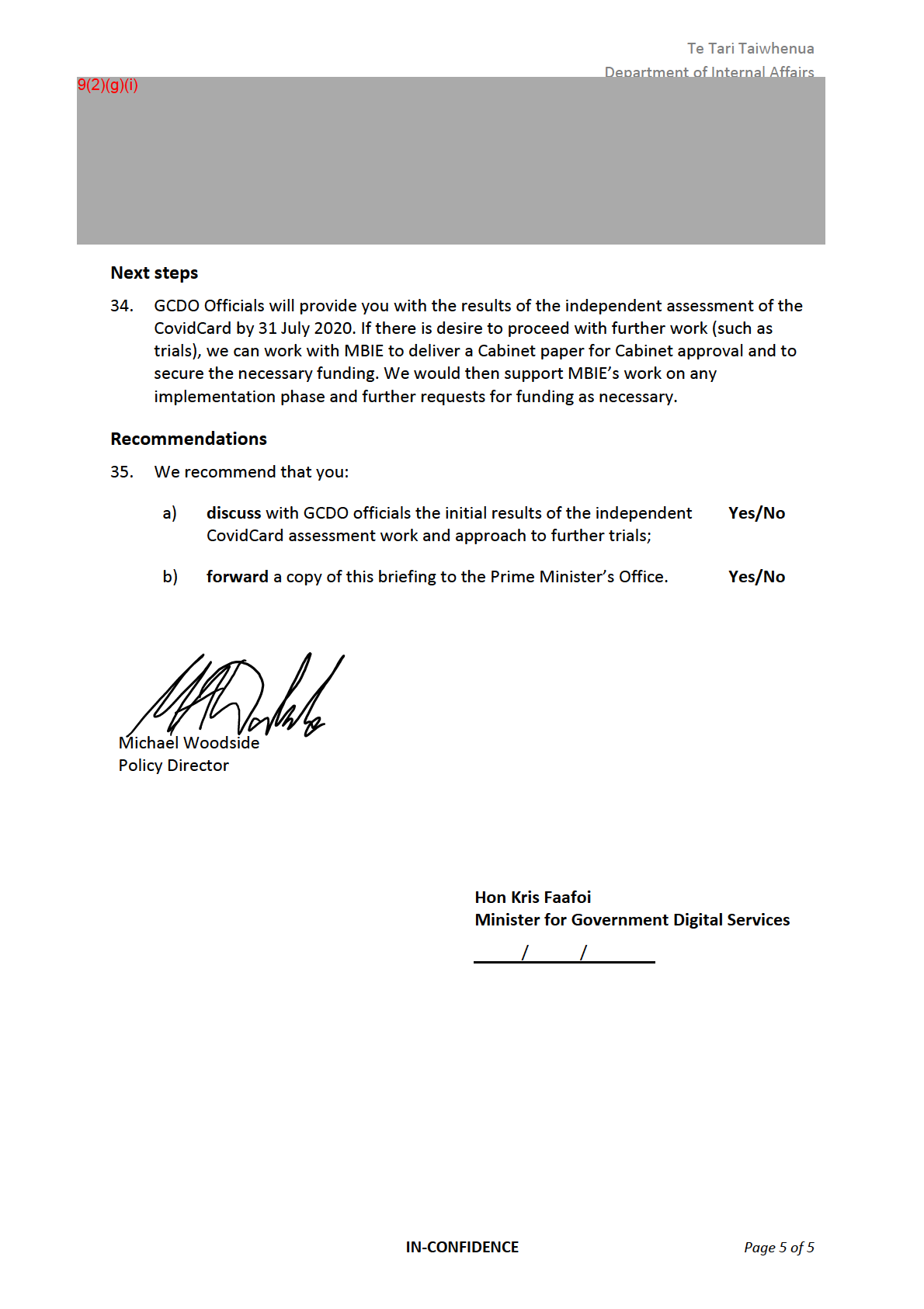
Te Tari Taiwhenua
Department of Internal Affairs
Purpose
1. This briefing provides an update about the current proof of concept work for the
CovidCard that the GCDO is leading, and sets out options for a further larger trial.
Background
2. We briefed you on 30 June 2020 about the investigation into the CovidCard. We noted
that further work is needed on proof of concept to ensure that:
• the card is technically feasible;
• adds value to the contact tracing process, and has epidemiological benefit; and
• would work if deployed at scale in a real-world environment.
3. The Ministry of Business, Innovation and Employment (MBIE) is leading work to assess
implementation options for the card and associated policy work. They are separately
briefing you on high-level design implementation options.
4. The Public Private Partnership Group (PPP) delivered their report on the card in early
June. This included their assessment of the card in terms of its technical feasibility and
epidemiological value. The assessment was based on research, a closed field trial at
Nelson Hospital, and significant product development testing in Waikato.
5. The GCDO has since been working with the Defence Technology Agency (DTA),
Ministry of Health, PPP, and the National Cyber Security Centre (NCSC) within the
Government Communications Security Bureau (GCSB), to test the findings of the PPP’s
report. This work will be completed at the end of July 2020.
Technical feasibility assessment update
6. DTA has undertaken an independent technical assessment of the card. The DTA’s draft
report found that the card can col ect contact data, that the battery would last for one
year, and that the card meets reasonable security and privacy expectations.
7. 6(a)
8. DTA recommended that a professional consultant should be approached to confirm its
view about the integrity of the card’s security. It also suggested that further testing of
the cards should be carried out, such as a 21-day test to assess battery life.
9. The DTA also noted that the cards will generate some false positives due to the nature
of the contact detection mechanism. To mitigate this, DTA recommends that contact
duration information also be stored on the cards.
10. Further work is underway with the PPP to discuss whether some of the issues that
were raised in the DTA report can be addressed. This includes how to reduce the
impact of false positives through how the card data is categorised (e.g. casual versus
close contacts) when it is incorporated into the National Contact Tracing System
(NCTS).
IN-CONFIDENCE
Page 2 of 5
Te Tari Taiwhenua
Department of Internal Affairs
Assessment of epidemiological benefit and value to contact tracing
11. An independent assessment of the epidemiological value of the card as outlined in the
PPP’s report is underway, with discussions held with the Ministry of Health regarding
the health modelling approach.
12. A workshop has been held with the Ministry of Health’s contact tracing experts to
discuss how the data from the card can add value to the existing contact tracing
approach. Work is underway to determine how the card data would integrate with
existing data and systems to support manual contact tracing. The results of this work
are due by the end of July 2020.
Further trial options
13. The decision to continue exploring the card and whether to undertake further trials
should be considered alongside the MBIE briefing on implementation design options
for the card and associated policy work (MBIE briefing 2021-0159 refers).
14. If deployment of the card is considered a potential option then further trials would be
useful to refine the hardware, test integration with the contact tracing system, and
test how well the card would perform in a real-world environment.
15. There are four options in terms of further trials:
15.1 No further trial(s) and Ministers decide on deployment (or not) based on
information available following completion of MBIE’s policy options work and
the independent proof of concept assessment;
15.2 Closed field trial (product development testing) only;
15.3 Combination of a closed field trial and larger scale community field trial;
15.4 Larger scale community field trial only.
16. The recommended approach, if this work is to continue, would be the combination of
a closed field trial and larger scale community field trial.
Closed field trial to refine the cards
17. This trial would be like the Waikato product development testing and would focus on
the technical aspects of the cards, including the performance of the card when not
worn on a lanyard in different settings, and the mitigation of false positives.
18. A closed trial is required to refine the technical aspects of the cards. This must be done
in a closed setting so that ground truth data can be gathered to determine if the cards
are recording information accurately.
19. The trial would be designed to validate the final production card specification and
could be done in paral el with the larger field trial.
Larger field trial
20. The purpose of the larger field trial would be to see how the card performs in a real-
world setting and to test the contact tracing download process for the cards and how
the data integrates with the NCTS.
21. The recommendation is that the trial be done in a smal community with around 250-
300 participants. Each participant would receive a card with a few cards picked at
random to be COVID-19 cases. The cardholder would be interviewed as if they were
IN-CONFIDENCE
Page 3 of 5
Te Tari Taiwhenua
Department of Internal Affairs
undergoing contact tracing and then this would be compared against the data
captured on the card.
22. Any trial larger than 300 cards is considered too challenging to manage logistically and
would not provide any significant further benefit in terms of analysis and testing the
contact tracing process.
23. 6(a)
24. Initial internal discussions are underway to determine a suitable community for the
trial should one proceed. We consider that there would be merit in promoting the trial
to a group that was digitally excluded to test uptake / usage. Some public consultation
would have to be done prior to beginning a trial.
25. This trial could also provide the opportunity for market research to test the public’s
willingness to carry a card for the purposes of contact tracing. Enabling an assessment
of behaviours around the card, such as how frequently people wear the card which
would help determine the card’s feasibility.
Roles and responsibilities
26. If further trials are to take place, a lead government agency for this work will need to
be determined. This agency would have oversight of the trials and responsibility for
reporting back to Ministers.
27. Either this lead agency or another agency would need to be responsible for col ecting
the data from the cards used in the larger trial and translating it into a format that is
usable to contact tracers.
28. This agency will also be responsible for ensuring robust security and privacy settings
are in place, to ensure the data collected by the cards will be held securely and then
destroyed after the trial ends.
29. The PPP will also need to be a core player in any trials for these to be effective given its
expertise on the card hardware 9(2)(j)
The University of
Otago may also be involved given its involvement in the initial Nelson trial.
Cost and timing
30. Previously $1 million of funding was provided via the Innovation Fund for the initial
work around the card. This funding was used as part of the independent assessment.
31. Work is underway to assess the cost of the recommended further trials option. To
undertake the trial in a robust manner and ensure the necessary privacy and security
protections are in place, it is estimated this work wil take at least two to three
months.
9(2)(g)(i)
IN-CONFIDENCE
Page 4 of 5


